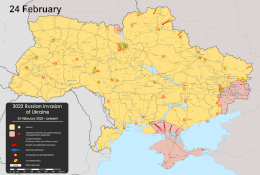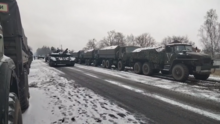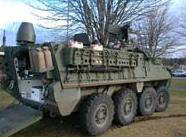Invasion
This article possibly contains original research. (April 2013) |
| Part of a series on |
| War |
|---|

An invasion is a
History
Before the days of package tours and cut-price airlines, military invasions functioned as a standard major form of proto-tourism[2] – bringing large numbers of foreign visitors into new environments, with the consequential social, cultural and economic impacts on indigenous populations and on the invaders.
Defenses

States with potentially hostile neighbors typically adopt

Alternatively, the fortifications can be built up at a series of sites, such as

In modern times, the notion of constructing large-scale static defenses to combat land-based threats has largely become obsolete. The use of precision air campaigns and large-scale
However, static emplacements remain useful in both defense against naval attacks and
In particularly large nations, the defending force may also retreat to facilitate a counterattack by drawing the invaders deeper into hostile territory. One effect of this tactic is that the invading force becomes too spread out, making supply difficult and making the lines more susceptible to attack. This tactic, although costly, helped the Soviets stop the German advance at Stalingrad.[6] It can also cause the invading force to extend too far, allowing a pincer movement to cut them off from reinforcements. This was the cause of the British defeat at the Battle of Cowpens during the American Revolutionary War.[7] Finally, sending too many reinforcements can leave too few defenders in the attackers' territory, allowing a counter-invasion from other areas, as happened in the Second Punic War.
Methods

There are many different methods by which an invasion can take place, each method having arguments both in their favour and against. These include invasion by land, sea, or air, or any combination of these methods.
By land
Invasion over land is the straightforward entry of
In modern warfare, invasion by land often takes place after, or sometimes during, attacks on the target by other means. Air strikes and cruise missiles launched from ships at sea are a common method of "softening" the target. Other, more subtle, preparations may involve secretly garnering popular support, assassinating potentially threatening political or military figures, and closing off supply lines where they cross into neighboring countries. In some cases, those other means of attack eliminate the need for ground assault; the 1945 atomic-bombing of Hiroshima and Nagasaki ultimately made it unnecessary for the Allies to invade the Japanese home islands with infantry troops. In cases such as this, while some ground troops are still needed to occupy the conquered territory, they are allowed to enter under the terms of a treaty and as such are no longer invaders. As unmanned, long-range combat evolves, the instances of basic overland invasion become fewer; often the conventional fighting is effectively over before the infantry arrives in the role of peacekeepers (see "Applications regarding non-state combatants" in this article).[citation needed]
By sea
Invasion by sea is the use of a body of water to facilitate the entry of armed forces into an area, often a landmass adjoining the body of water or an island. This is generally used either in conjunction with another method of invasion, and especially before the
By air

Invasion by air is an invention of the 20th century and modern warfare. The idea involves sending military units into a territory by aircraft. The aircraft either land, allowing the military units to debark and attempt their objective, or the troops exit the aircraft while still in the air, using parachutes or similar devices to land in the territory being invaded. Many times air assaults have been used to pave the way for a ground- or sea-based invasion, by taking key positions deep behind enemy lines such as bridges and crossroads, but an entirely air-based invasion has never succeeded. Two immediate problems are resupply and reinforcement. A large airborne force cannot be adequately supplied without meeting up with ground forces; an airborne force too small simply places themselves into an immediate envelopment situation. Arguments in favor of this method generally relate to the ability to target specific areas that may not necessarily be easily accessible by land or sea, a greater chance of surprising the enemy and overwhelming defensive structures, and, in many cases, the need for a reduced number of forces due to the element of surprise. Arguments against this method typically involve capacity to perform such an invasion—such as the sheer number of planes that would be needed to carry a sufficient number of troops—and the need for a high level of intelligence in order for the invasion to be successful.[citation needed]
The closest examples to a true air invasion are the
Pacification

Once political boundaries and military lines have been breached, pacification of the region is the final, and arguably the most important, goal of the invading force. After the defeat of the regular military, or when one is lacking, continued opposition to an invasion often comes from civilian or paramilitary resistance movements. Complete pacification of an occupied country can be difficult, and usually impossible, but popular support is vital to the success of any invasion.[citation needed]
Media
Support
Logistics

Without a steady flow of supplies, an invading force will soon find itself retreating. Before his invasion of
In most invasions, even in modern times, many fresh supplies are gathered from the invaded territories themselves. Before the
Communication

Another consideration is the importance of leadership being able to communicate with the invasion force. In ancient times, this often meant that a king needed to lead his armies in person to be certain his commands were timely and followed, as in the case of Alexander the Great (356–323 BCE). At that time, the skills needed to lead troops in battle were as important as the skills needed to run a country during peacetime. When it was necessary for the king to be elsewhere, messengers would relay updates back to the rear, often on horseback or, in cases such as the Battle of Marathon (490 BCE), with swift runners.[citation needed]
When possible,
The development of
Public relations

In diplomatic, public relations and propaganda terms, it may help an invader (or a potential invader) to have an invitation as an excuse to intervene with a view to "restoring order" or "righting wrongs". Dissident groups, fifth columns or official circles may conspire to "call in" foreign assistance. Cases include:
- From the point of view of the Byzantine Empire, the First Crusade's invasion and conquest of the Levant (1096–1099) resulted from an invitation issued by Emperor Alexios I Komnenos in 1095, seeking assistance against the Turks in Anatolia.
- English barons opposed to King John invited the French Prince Louis to undertake a French invasion of England in the First Barons' Warof 1215–1217.
- In 1688 an invitation to William of Orange to invade Britain helped the Glorious Revolution.
- Expédition d'Irlande, 1796) in the lead-up to the Irish Rebellion of 1798.
- Some members of the Communist Party of Czechoslovakia allegedly called for Soviet intervention during the Prague Spring of 1968, which ended with the Warsaw Pact invasion of Czechoslovakia in August 1968.
National foundation-legends can echo the theme of inviting foreign warriors to come and rule a people: note the traditional account in the ).
In contrast, in modern times, a defender can improve public relations with a right message: Ukrainanian President Volodymyr Zelenskyy's popularity was suffering after years of his presidency, but during the Russian invasion of Ukraine in 2022 his popularity improved dramatically, while Putin's image of a calculating strategist was damaged and Russia was growingly being seen as a pariah in the international stage.[14]
Applications regarding non-state combatants
In the 20th and 21st centuries, questions arose regarding the effectiveness of the invasion strategy in neutralizing non-state combatants, a type of warfare sometimes referred to as "
An opposing theory holds that, in response to extremist ideology and unjust governments, an invasion can change the government and reeducate the people, making prolonged resistance unlikely and averting future violence. This theory acknowledges that these changes may take time—generations, in some cases—but holds that immediate benefits may still be won by reducing membership in, and choking the supply lines of, these covert cells. Proponents of the invasion strategy in such conflicts maintain the belief that a strong occupying force can still succeed in its goals on a tactical level, building upon numerous small victories, similar to a war of attrition.[17]
Contemporary debate on this issue is still fresh; neither side can claim to know for certain which strategies will ultimately be effective in defeating non-state combatants. Opponents of the invasion strategy point to a lack of examples in which occupying or
Outcomes
The outcomes of an invasion may vary according to the objectives of both invaders and defenders, the success of the invasion and the defense, and the presence or absence of an agreed settlement between the warring parties. The most common outcome of a successful invasion is the loss of territory from the defender, generally accompanied by a change in government and often the loss of direct control of that government by the losing faction. This sometimes results in the transformation of that country into a client state, often accompanied by requirements to pay reparations or tribute to the victor. In other cases the results of a successful invasion may simply be a return to the status quo; this can be seen in wars of attrition, when the destruction of personnel and supplies is the main strategic objective,[21] or where a nation previously subdued and currently occupied by an aggressive third party is restored to control of its own affairs (i.e. Western Europe following the Normandy landings in 1944, or Kuwait following the defeat of Iraq in 1991). In some cases, the invasion may be strategically limited to a geographical area, which is carved into a separate state as with the Bangladesh Liberation War in 1971.
See also
- Aggression
- Combat
- Conquest
- Invasion literature
- List of invasions
- Military occupation
- Military rule
- Power projection
- Sovereignty
- Trespass
- War of aggression
References
- ^
Bagnall, Nigel (1990). The Punic Wars: Rome, Carthage, and the Struggle for the Mediterranean. Thomas Dunne Books. ISBN 0-312-34214-4.
- ^
Compare:
Sharma, K. K. (1999). Tourism and Culture. Sarup & Sons. p. 30. ISBN 978-8176250566. Retrieved 21 May 2020.
From its beginnings tourism is a kind of secondary invasion, secondary to outright military invasion or economic penetration.
- ^ Defense Update (2006). "Accelerating the Kill Chain: Closing the Sensor-to-shooter Cycle". Archived from the original on February 6, 2006. Retrieved February 11, 2006.
- ^ Mason, Gerald A. (2002). "Operation Starvation". Archived from the original on March 28, 2005. Retrieved February 11, 2006.
- ISBN 0-275-98345-5.
- ^ Matters, James T. (2003). "Stalingrad – The Nazis Reach Beyond Their Grasp". Archived from the original on December 26, 2005. Retrieved February 16, 2006.
- ^ Withrow, Scott (2005). "The Battle of Cowpens". Retrieved February 16, 2006.
- ^ Ashton, Douglas F. (1989). "Tarawa: Testing Ground For The Amphibious Assault". Retrieved February 11, 2006.
- ISBN 1-877702-03-X.
- ^ Schuurman, J. and De Jong, P. (2001). "The Legacy of Bobby Sands". Retrieved February 14, 2006.
{{cite web}}: CS1 maint: multiple names: authors list (link) - ^ Rowland, Stephen (2005). "Persian society in the time of Darius and Xerxes". Archived from the original on February 24, 2006. Retrieved February 24, 2006.
- ^ Polybius (1922). "The Histories, Book III". Retrieved February 24, 2006.
- ^ U.S. Army (2005). "Background of ALMC". Archived from the original on February 23, 2006. Retrieved February 24, 2006.
- ^ LINTHICUM, KATE; BULOS, NABIH (2022-02-28). "Ukraine is winning — at least in the public relations battle". Los Angeles Times. Retrieved 2023-07-21.
The war for Ukraine may be far from decided, but in the public relations battle, Zelensky is clearly winning. [...] As a possible conflict with Moscow loomed in recent months, many Ukrainians wondered whether Zelensky had the steel nerves a wartime president needed to keep the country together against the formidable Russian force [...] But in the four days since Russia invaded, Zelensky has shone
- ^ Hackworth, David H. (2004). "Fallujah: Saved for Democracy?". Retrieved February 19, 2006.
- ^ Lind, William S. (2003). "Understanding Fourth Generation War". Retrieved February 19, 2006.
- ^ North, Oliver L. (2005). "Winning in Iraq, One Step at a Time". Retrieved February 19, 2006.
- ^ Lind, William S., op. cit.
- ^ North, Oliver L. (2004). "Operation Pessimism and Perplexity". Retrieved February 19, 2006.
- ^ Moore, Steven (2004). "The Truth About Iraq: Media Bias". Archived from the original on February 7, 2006. Retrieved February 19, 2006.
- ^ Brush, Peter (1994). "Civic Action: The Marine Corps Experience in Vietnam". Archived from the original on February 8, 2006. Retrieved February 11, 2006.
